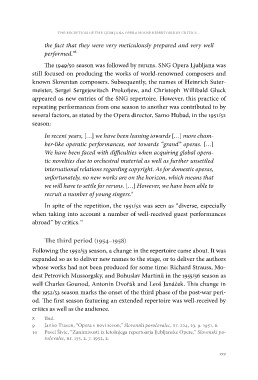Page 401 - Weiss, Jernej, ur. 2019. Vloga nacionalnih opernih gledališč v 20. in 21. stoletju - The Role of National Opera Houses in the 20th and 21st Centuries. Koper/Ljubljana: Založba Univerze na Primorskem in Festival Ljubljana. Studia musicologica Labacensia, 3
P. 401
the reception of the ljubljana opera house repertoire by critics ...
the fact that they were very meticulously prepared and very well
performed.”8
The 1949/50 season was followed by reruns. SNG Opera Ljubljana was
still focused on producing the works of world-renowned composers and
known Slovenian composers. Subsequently, the names of Heinrich Suter-
meister, Sergei Sergejewitsch Prokofjew, and Christoph Willibald Gluck
appeared as new entries of the SNG repertoire. However, this practice of
repeating performances from one season to another was contributed to by
several factors, as stated by the Opera director, Samo Hubad, in the 1951/52
season:
In recent years, […] we have been leaning towards […] more cham-
ber-like operatic performances, not towards “grand” operas. […]
We have been faced with difficulties when acquiring global opera-
tic novelties due to orchestral material as well as further unsettled
international relations regarding copyright. As for domestic operas,
unfortunately, no new works are on the horizon, which means that
we will have to settle for reruns. […] However, we have been able to
recruit a number of young singers.9
In spite of the repetition, the 1951/52 was seen as “diverse, especially
when taking into account a number of well-received guest performances
abroad” by critics.10
The third period (1954–1958)
Following the 1952/53 season, a change in the repertoire came about. It was
expanded so as to deliver new names to the stage, or to deliver the authors
whose works had not been produced for some time: Richard Strauss, Mo-
dest Petrovich Mussorgsky, and Bohuslav Martinů in the 1955/56 season as
well Charles Gounod, Antonín Dvořák and Leoš Janáček. This change in
the 1952/53 season marks the onset of the third phase of the post-war peri-
od. The first season featuring an extended repertoire was well-received by
critics as well as the audience.
8 Ibid.
9 Janko Traven, “Opera v novi sezon,” Slovenski poročevalec, nr. 224, 23. 9. 1951, 6.
10 Pavel Šivic, “Zanimivosti iz letošnjega repertoarja ljubljanske Opere,” Slovenski po-
ročevalec, nr. 155, 2. 7. 1952, 2.
399
the fact that they were very meticulously prepared and very well
performed.”8
The 1949/50 season was followed by reruns. SNG Opera Ljubljana was
still focused on producing the works of world-renowned composers and
known Slovenian composers. Subsequently, the names of Heinrich Suter-
meister, Sergei Sergejewitsch Prokofjew, and Christoph Willibald Gluck
appeared as new entries of the SNG repertoire. However, this practice of
repeating performances from one season to another was contributed to by
several factors, as stated by the Opera director, Samo Hubad, in the 1951/52
season:
In recent years, […] we have been leaning towards […] more cham-
ber-like operatic performances, not towards “grand” operas. […]
We have been faced with difficulties when acquiring global opera-
tic novelties due to orchestral material as well as further unsettled
international relations regarding copyright. As for domestic operas,
unfortunately, no new works are on the horizon, which means that
we will have to settle for reruns. […] However, we have been able to
recruit a number of young singers.9
In spite of the repetition, the 1951/52 was seen as “diverse, especially
when taking into account a number of well-received guest performances
abroad” by critics.10
The third period (1954–1958)
Following the 1952/53 season, a change in the repertoire came about. It was
expanded so as to deliver new names to the stage, or to deliver the authors
whose works had not been produced for some time: Richard Strauss, Mo-
dest Petrovich Mussorgsky, and Bohuslav Martinů in the 1955/56 season as
well Charles Gounod, Antonín Dvořák and Leoš Janáček. This change in
the 1952/53 season marks the onset of the third phase of the post-war peri-
od. The first season featuring an extended repertoire was well-received by
critics as well as the audience.
8 Ibid.
9 Janko Traven, “Opera v novi sezon,” Slovenski poročevalec, nr. 224, 23. 9. 1951, 6.
10 Pavel Šivic, “Zanimivosti iz letošnjega repertoarja ljubljanske Opere,” Slovenski po-
ročevalec, nr. 155, 2. 7. 1952, 2.
399


